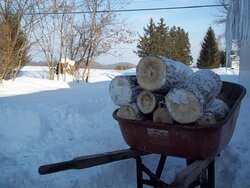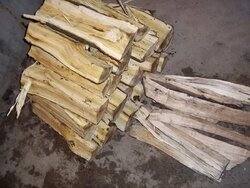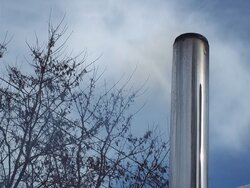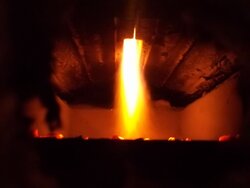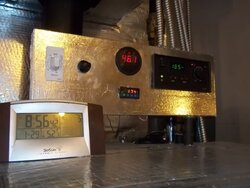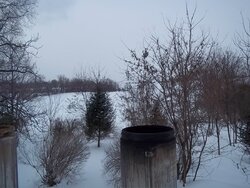"For a number of years I have been familiar with the observation that the quality of wood fuel is a decreasing function of its moisture content. More recently I discovered why the use of the green wood has such disastrous effects, and I became convinced that green wood should be abolished from all 'gasification' wood burning appliances." [With apologies to EWD.]
Or so the story goes. You never know until you try.
I didn't have any green wood, plus I wanted to be sure it was indeed green, so I took a few minutes to go out to fell and split a couple hundred pounds of the real thing this morning. [See photos.]
Now even I will concede you can't burn what isn't lit, so I placed a six-inch bone-dry well-split round over the nozzle , filled the firebox with nice fresh wood, and touched it off.
Well I can't say it burned normally, but with a couple of adjustments it certainly burned hot and clean.
First off I placed a 'throttle' plate over 60% of the nozzle so as to avoid the rookie mistake of too much carburetor.
Next I changed my return temperature setpoint from my normal 71 degC / 160 degF to 80 degC / 176 degF.
Primary air was increased from 1mm to 2mm (whatever that means).
And flue neck setpoint was changed from 145 degC / 293 degF to 175 degC / 347 degF.
The load gasified from the get-go, flue gases were transparent, and rate of heated water production was greater than normal (due to higher flue neck setpoint).
Certainly there was a certain amount of live steam going up the flue, but it hardly seems as disastrous as I would have expected.
Or so the story goes. You never know until you try.
I didn't have any green wood, plus I wanted to be sure it was indeed green, so I took a few minutes to go out to fell and split a couple hundred pounds of the real thing this morning. [See photos.]
Now even I will concede you can't burn what isn't lit, so I placed a six-inch bone-dry well-split round over the nozzle , filled the firebox with nice fresh wood, and touched it off.
Well I can't say it burned normally, but with a couple of adjustments it certainly burned hot and clean.
First off I placed a 'throttle' plate over 60% of the nozzle so as to avoid the rookie mistake of too much carburetor.
Next I changed my return temperature setpoint from my normal 71 degC / 160 degF to 80 degC / 176 degF.
Primary air was increased from 1mm to 2mm (whatever that means).
And flue neck setpoint was changed from 145 degC / 293 degF to 175 degC / 347 degF.
The load gasified from the get-go, flue gases were transparent, and rate of heated water production was greater than normal (due to higher flue neck setpoint).
Certainly there was a certain amount of live steam going up the flue, but it hardly seems as disastrous as I would have expected.


